14 June 2013
In response to great demand, we have decided to publish on our site the long and extraordinary interviews that appeared in the print magazine from 2009 to 2011. Forty gripping conversations with the protagonists of contemporary art, design and architecture. Once a week, an appointment not to be missed. A real treat. Today it’s Flavio Favelli’s turn.
Klat #05, spring 2011.
Lamps, carpets, bottles, wardrobes, chairs, armchairs: gathered and reassembled through careful craftsmanship, to pursue and exorcise the past. Flavio Favelli, born in 1967, uses mostly furniture, ceramics and a few selected products to construct environments that take him back to his childhood, his adolescence, to try to understand their mechanisms and re-experience their atmosphere. Traces of his own memory materialized through furnishings capable of narrating a time that is, however, above all private. Flavio Favelli grew up in the seventies, through the darkest years of the Italian Republic, but his focus is not on political and historical events, exceptional or tragic as they may be; it is on the impression that was made on his psyche in those formative years. Favelli’s gaze at the past, then, is always solitary: he does not take part in that widespread concentration of many Italian artists in the last few decades of our country’s history. The voluntary solitude of the life and work of Flavio Favelli emerges forcefully in every one of his projects, even in the case of public works. The bars created for the MAMBO in Bologna and the MARCA of Catanzaro are magnificent, perfect down to the smallest details, with visual references balanced to form a unique whole: almost as if they were still furnishings conceived to contain objects and memories, not places that can welcome other persons with their own independent movement. Flavio Favelli has had many solo shows in public and private spaces in Italy and abroad; in 2010 he was assigned the Italian Fellowship at the American Academy in Rome.
Looking at your work it is not easy to outline the development of your artistic path: how did you begin to be interested in art?
I often think, and I am more and more convinced, that it was by chance: I was completing my university studies, in history, and my maternal grandmother, from Bologna, left me an apartment on Via Guerrazzi in that city, right in front of the old DAMS. Looking around I found nothing that met my desires, so I began to build the furnishings for my house, even though I knew absolutely nothing about it, from a technical viewpoint. I’ve never stopped doing it since. So everything began with my own personal needs. Later there was another important, and again random, experience. I decided to be a conscientious objector (at the time to avoid the draft you could get assigned to alternative service), they sent me to work in a library near Reggio Emilia. In the periodicals section, I found a copy of Il Sole 24 Ore, which otherwise I would never have read: it mentioned a sculpture course conducted by Arnaldo Pomodoro (I was acquainted with his work but I didn’t know him) in the Marche. I don’t even know why, but I enrolled for the course. It lasted three months, I understood that there was also an art world, and I began to spend time in it.
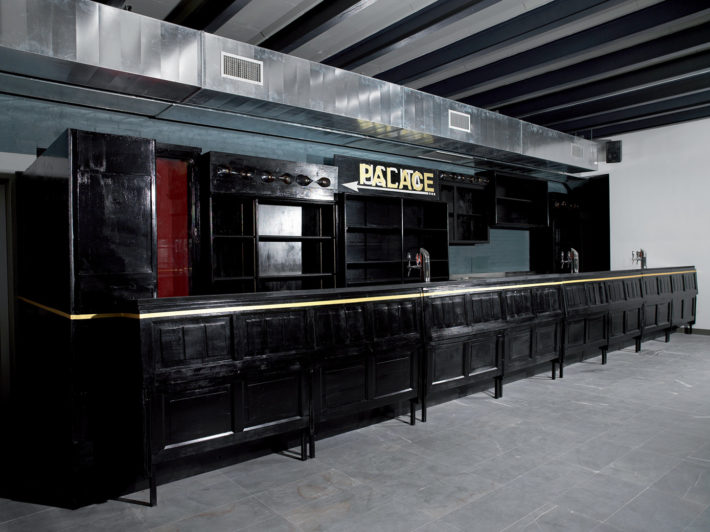
Flavio Favelli, Palace, Bar MAMBO, Bologna, 2007. Photo: Dario Lasagni.
I imagine you began to go to galleries and museums: were their other figures of artists that interested you, that guided you?
I grew up in terms of art at the Link in Bologna, a squat that wasn’t particularly radical in political terms, and very open to experimentation. Groups like Motus or Raffaello Sanzio performed there, and they now have an international following. Before that experience I had never practiced art. Remember, I came from majoring in history at the university. But I had traveled extensively with my mother, a professor of literature, in Italy and Europe, to visit many museums. Later I started to understand that the images I was making, my works, could be positioned in a system with its own rules. It might seem banal, but from the outside it is not easy to understand that there is a system made of galleries, critics, etc. Also in this perspective, I feel I am self-taught. At a certain point I understood that I had to establish a dialogue with the people in the art world, and I met Francesca Pasini, a critic. I had just shown some doors at the Galleria Maze in Turin: the references were to my house and my family, because I have always tried to reconstruct my past, because I think it is intense and particular. I chose to use the doors from a house my mother had renovated, and Francesca Pasini almost scolded me, saying I should be careful with doors, because there was an outstanding precedent for their use, namely that of Duchamp. This was the first time I understood the potential conflict between my images, my history, and the images that made art history. I decided that they might be overlapped, as in the case of the doors; I felt I could not do without them, because they had been witnesses to events that were serious and traumatic for my family. In short, I understood that I had to establish a dialogue with the art world, even though I found its rules rather restrictive…
Is the choice of gathering and accumulating furniture also a way of constructing your autobiography?
At the moment the first floor of my house is completely filled with furniture that will be turned into works… When I was a boy one of the first books my mother gave me to read was about Howard Carter and the discovery of the tomb of Tutankhamun. Every since, I have always been very interested in the tombs of the pharaohs. The idea that the pharaohs could take their objects into the afterlife has always fascinated me. I said to myself: I want to do that too, but I want to do it now, in this world, selecting important objects, furniture, table services, smaller things, memories. Yes, my work is clearly autobiographical, my works are fragments of bourgeois homes. My grandfather, who was a military man and a very conservative person, collected art, not because he was truly interested, but because he wanted to invest and he loved colonial objects – embarrassing as that might seem today. In those houses packed with briar furniture and objects I was a solitary boy, an only child. Over the years I have understood that all that pomp, that bourgeois aesthetic, that apparent calm, was just a facade. Actually, my family was not in very good financial shape.
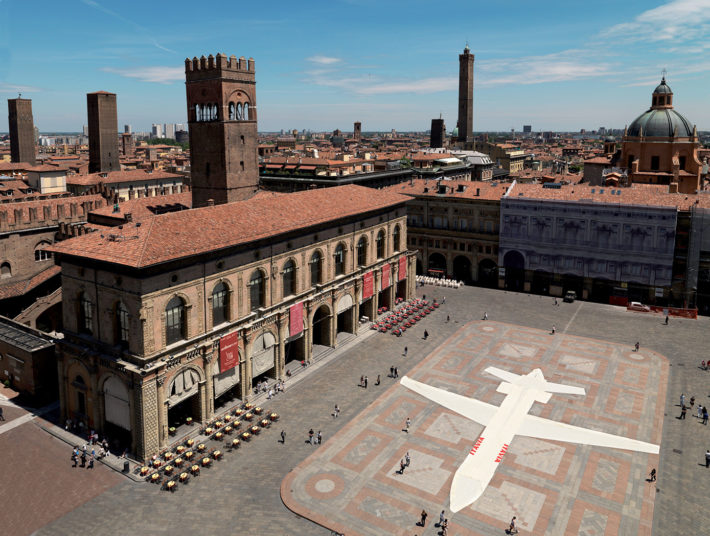
Flavio Favelli, Cerimonia (India Hotel 870), Bologna, 2007-2010. Courtesy: Fondazione Sandretto Re Rebaudengo. Photo: Dario Lasagni.
Things were not going well with your family?
For a few years now I have been my father’s legal guardian: he isn’t well, he suffers from schizophrenia, he has even been declared incompetent, after a great many problems. When I became his guardian I inherited entire boxes full of documents, written on carbon paper as was done in the past, letters from lawyers, some from the Roman Rota: they really contain the history of my country, of the seventies, and my name appears in them everywhere. My father wanted to be a poet and when I told my mother that my future would be in art, she said that we had already had one artist in the house…
So your mother was fundamental for your early approach to art. What does she say now that you are a successful artist?
We don’t have an easy relationship, but my mother has always been a very great lover of art with a capital “A”: in 1980 we went to Moscow to visit exhibitions, when it was still not easy to enter the Soviet Union. But I also remember a phrase that for me sums up the thinking of someone interested in art, with a good education (she had a degree in German literature, and when she was cooking she often sang Goethe), but someone who also never took more recent developments in art very seriously. We were at a Picasso exhibition and she said: “Maybe he painted with pink because he had no money”. A wisecrack to liquidate modern art. She is probably amazed now if her colleagues or friends tell her they’ve seen my name in a newspaper. In any case, when I see her we usually talk about family matters.
Though you are the grandson of a collector, I don’t think the supply of materials from your family homes could be infinite. How and where do you find the objects you need for an installation?
I gather everything that interests me. I’ve been living for seven years in the Apennines, near Bologna, in a large house with a big studio, a space I could never afford in the city. There I can easily gather all the objects that remind me of family environments. Objects I then cut up and reassemble in a rather perverse way, constructing other things. I often go to markets, at this point I have people who contact me when there is some object that might be of interest: something strange, unpredictable, maybe a cabinet three or four meters long, something they think I could use to make an installation. I also like big quantities: in one project I did two years ago for a secular funeral facility at the Certosa of Bologna, in the monumental cemetery, I decided to use about fifty old lamps, all identical, I had collected over the years. For me that was really very interesting, to put them together to create an environment with such a particular, delicate function.
What is your relationship with design? Would you like your works to become objects, independent of the artistic installations?
Once, when I gave a lecture at the Turin Polytechnic, a student correctly pointed out that I had shown photographs of spaces without people. Let’s say that though I can imagine the possibility of someone using my objects, it is as if this eventuality had nothing to do with me, as if it were only a mental projection.
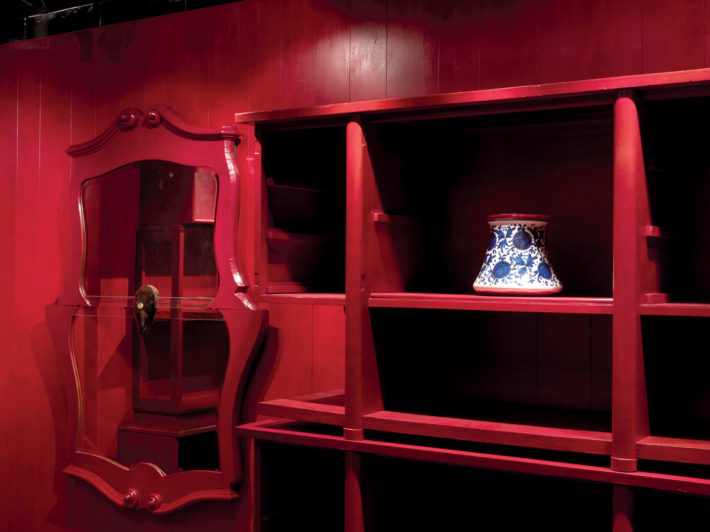
Flavio Favelli, China Red, detail, 2009. Photo: Dario Lasagni.
What would happen if they were put into production, and put on the market in large quantities?
That is a very delicate matter. I have often had offers, especially for the lamps, but I don’t really think that is my path. There are too many limits in design: for certain artists they represent a challenge, but for me they are just limits.
How important is craftsmanship for you? Do you work alone, or do you collaborate with specialists who are familiar with the materials you choose?
I have always wanted to be independent. Living in this small town, in an isolated place where I don’t know anyone, forces me to do everything on my own. With a few exceptions. For example, I have the unconditional assistance of a smith and a carpenter: sometimes they even let me use their workshops when I have problems, and I think that couldn’t happen in the city. Artists always have problems that happen saturday night between 8 PM and 11 PM, and in that moment having someone ready to help is fundamental. Otherwise I’ve invented it all on my own, my studios are really full of equipment of all kinds, I can also cut mirrors, I like to work by myself.
You are a decidedly solitary person: you live alone in the mountains, you like to work alone…
I often get snowbound up there, but it is not a problem. When I was in college I thought going to the movies or the theater was fundamental. Now, instead, I realize that I haven’t been to such places in years, I work a lot and I don’t miss those experiences. It is also true that I alternate periods of complete solitude with frequent travels, it is the only way I can do things: I work with one gallery in Milan, another in Rome, and I often go to Sicily…
Apart from your personal desire for solitude, I think the issue is a bigger one: while during the last century artists felt the need to be in the city, today many of them want to stay away from it. Is this also because the relationship with other artists is less important now?
Yes, this aspect has always created problems for me: I have ongoing relationships with only a few people in the art world. I also realize that sometimes I have to choose projects or residencies that call for collaboration and travel, but my impulse is to always stay alone, to work. There are some artists who work in groups or as a couple, but those dynamics are very far from my way of being. I believe the question of art, in the end, has to do with one person only, though many critics and journalists seem to be more interested in artists whose work is connected to political or social questions. Instead, I always talk about a private question, my childhood, my country. I believe that stories can be perceived as universal when they are deeply intimate, personal.
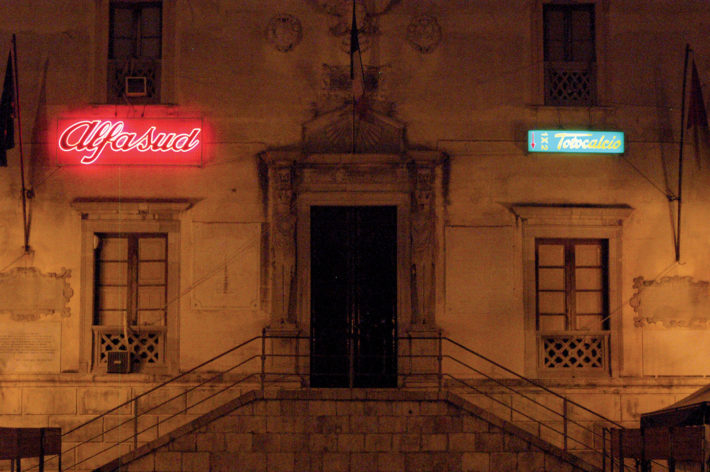
Flavio Favelli, Alfasud 1×2, Termini Imerese, 2010. Courtesy: Palazzo Riso, Palermo.
The intimate, biographical aspect is predominant in your work, but there are also public projects, or in any case projects regarding collective events. I am thinking, first of all, of the installation on the massacre of Ustica in 1980.
Yes, but in all the interviews I have specified that the project began when I was thirteen years old and saw, in the newspaper Resto del Carlino, an expanse of black sea (the printing was only in black and white, at the time), with a little white man, the first corpse, emerging from the water. I was in the Apennines, at that moment my family was going through a bad time, and that photograph made a powerful impression on me. I’ve never forgotten it, because evidently it managed to communicate to the boy I was. Moreover, I have always been afraid of the sea, and when I did the project for Fondazione Sandretto Re Rebaudengo in Turin I gave it the title Abissi: I began to think that, in the end, my abysses and those of my family were also those of my country. Forty days later came the bombing in Bologna, but there was no image that was able to transmit such a strong signal to me. It is no coincidence that I have made a work on that subject. Really, I am not an artist who investigates the burning issues of our country: my perspective has always been personal, even when it comes into contact with the events of our recent history. I grew up in the seventies, and then during the Cold War, in a very intense period, with respect to the present: it would be impossible not to have been crossed, influenced, even if only indirectly.
In your summoning of the past at times objects appear that were particularly widespread in those years, like the jars of Fabbri black cherries…
The design of the Amarena Fabbri jar interests me above all in relation to the fact that I am a westerner: as a former history student, I wondered about the problem of our way of looking at others. My grandfather had many Chinese objects in his collection, and I thought of China as the exotic place par excellence, I always found it fascinating. The Amarena Fabbri jar is interesting because it is based on a very old Chinese design imported by the East India Company, and in effect this company always was involved with art and design, before such things were in vogue. I feel like a product of western culture, which unfortunately has seen the Orient only as a source of objects to import: a carpet, a cup, a piece of furniture. Without showing any interest in the other aspects. The Martini bottle, on the other hand, represents a sort of Trojan horse, for me. I remember there were these bottles at home, with a military label, of the house of Savoy, with lots of medals. Toward the end of the seventies, though, on the back of the bottle girls appeared in bikinis, or the message “on the rocks” (in English, ed.): for me, the Martini bottle became the symbol of a world that was changing. I have lots of them at home, I cut them up and put them back together. In one work I even created Martini Extra, which doesn’t exist, but is the sum of many bottles of Martini Rosso, Bianco, Rosé….
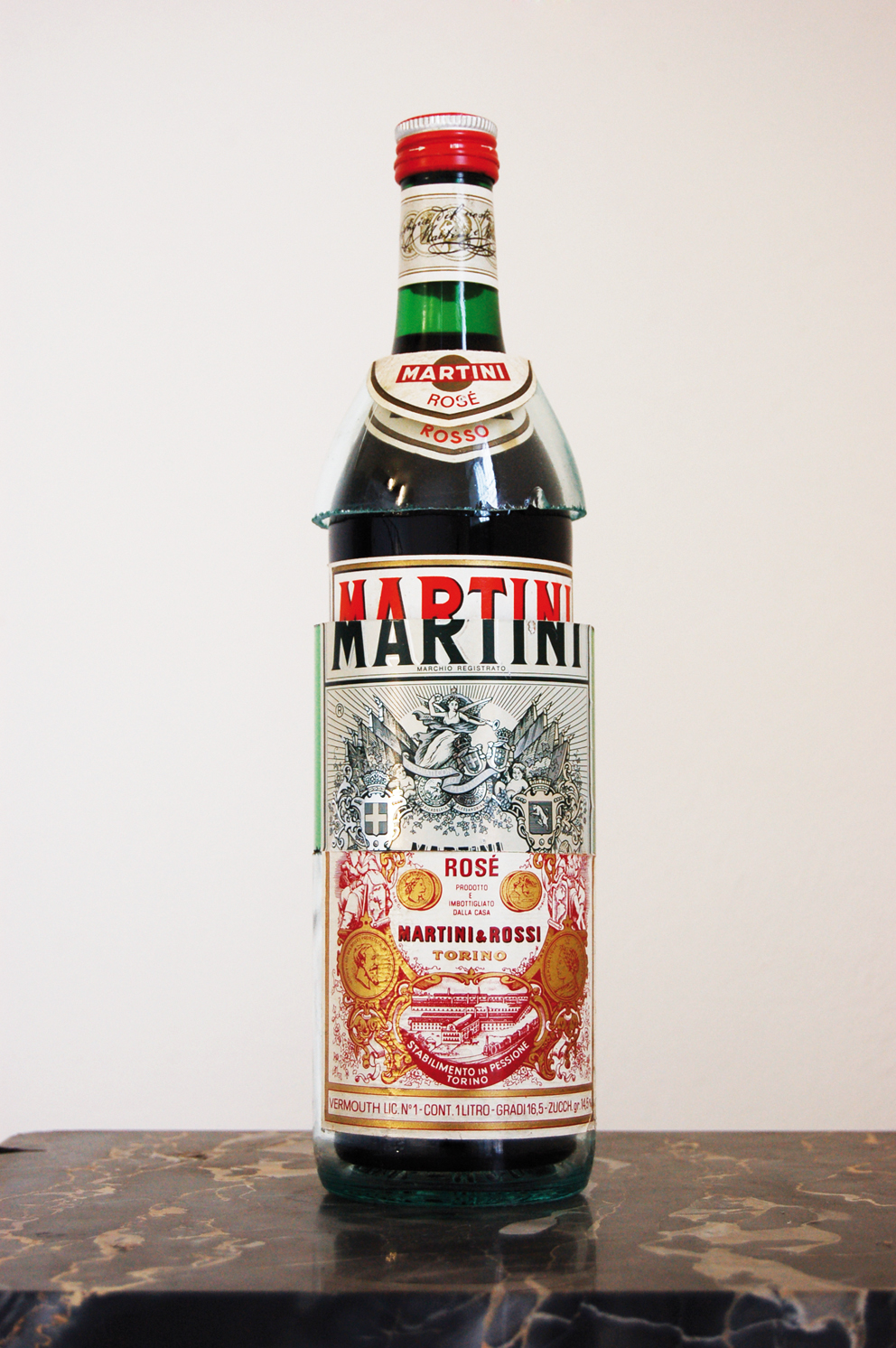
Flavio Favelli, Martini Extra 1, 2007.
What are you working on right now?
I am working on a large, ambitious project for my house at Savigno, which I purchased from the Diocesan Institute for the Support of the Clergy. I want to completely cover the house with a box. For one year the town government refused to approve the project because the house is close to a small church, and according to the mayor my idea was too modern, and would clash with the traditional architecture of the chapel. But I talked with the mayor and I have managed to convince him. It will be a parallelepiped, entirely covered with ceramic material or plastic: I would like to build a large shack with an external skin that changes over time, so I am thinking of plastic or tar sheets. The proportions would be large, it will be noticed throughout the valley, and I think it is an important project because in Italy, in the country, it has become impossible to experiment, especially in regions like Tuscany or Umbria. Many friends of mine tease me about it, saying I am building my own mausoleum, after having done a project connected with the Mausoleum of Theodoric for the Centro Arti Visive Pescheria in Pesaro. I am also working on a group show that is very important to me, it will be held in Palermo, at the museum of Palazzo Riso, and curated by Daniela Bigi, with many artists who gathered there for a period of residency, an experience that has led up to the show. I am particularly pleased about this, because I have always been fascinated by Sicily: I find things there that no longer exist on the Continent, the materialization of many fragments of my past, because in spite of it all, in Sicily they tend to conserve things, to remember things.